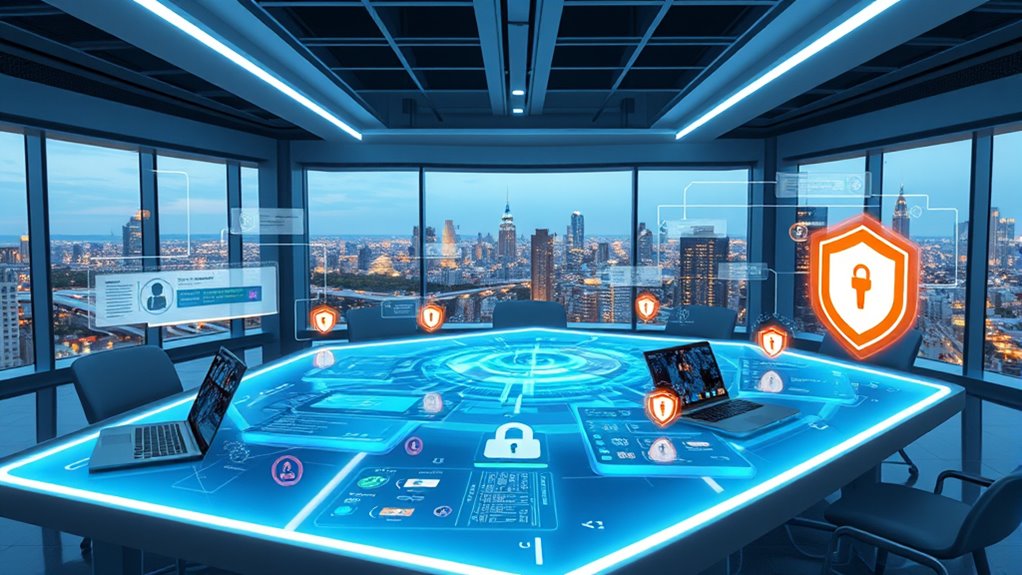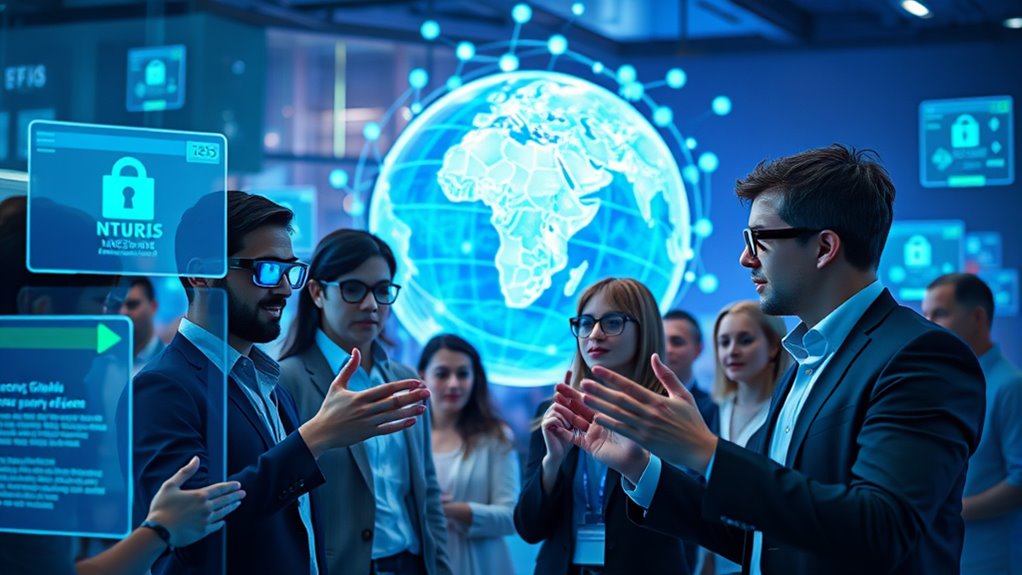By 2025, end-to-end encryption (E2EE) will be standard in real-time collaboration tools, ensuring your chats, video calls, and document edits stay private from start to finish. Advanced encryption protocols and user authentication methods will work seamlessly together, protecting your sensitive data without causing disruptions. Security features will become more intuitive and less intrusive, giving you confidence in your team’s privacy. To discover how these innovations keep your information secure, explore these upcoming capabilities further.
Key Takeaways
- End-to-end encryption will secure real-time data during video calls, chats, and document editing in collaboration tools by 2025.
- Encryption protocols like TLS and Signal Protocol will be more integrated and user-friendly, ensuring seamless privacy.
- Advanced cryptography and algorithm improvements will enhance security without disrupting user experience.
- Authentication methods such as MFA and biometric verification will be context-aware, strengthening access control.
- Security features will be more transparent, reducing user intervention while maintaining robust real-time data protection.

End-to-end encryption (E2EE) has become vital for securing real-time collaboration tools, guaranteeing that your data remains private from end to end. When you share sensitive information during a video call, chat, or document editing session, encryption protocols are the backbone that protect that data from interception or unauthorized access. These protocols, such as TLS and Signal Protocol, establish secure channels that scramble your messages so only you and your intended recipients can decipher them. As technology advances toward 2025, these encryption standards are becoming more robust, seamlessly integrating into collaboration platforms without impacting user experience. You won’t notice complex processes; instead, you’ll benefit from transparent security that safeguards your conversations and files.
End-to-end encryption ensures your collaboration data stays private and secure, seamlessly protecting your conversations and files without disrupting your workflow.
User authentication also plays a vital role in maintaining the integrity of your collaboration environment. It verifies that only authorized individuals can access the shared data, preventing intruders from sneaking in. Modern authentication methods, such as multi-factor authentication (MFA) and biometric verification, are becoming standard features in collaboration tools. These measures add extra layers of security, making it harder for hackers to compromise your sessions. As systems evolve, authentication protocols are increasingly leveraging decentralized identity frameworks and zero-trust architectures, meaning every access request is thoroughly verified before granting entry. This approach guarantees that even if someone manages to breach one part of your system, the overall security remains intact.
In 2025, you can expect these encryption protocols and user authentication methods to work together seamlessly. Encryption ensures your data stays private during transmission and storage, while authentication confirms you’re the rightful user with access rights. When you initiate a collaboration session, sophisticated protocols verify your identity instantly, then encrypt your data on your device before transmitting it through secure channels. This tight integration prevents eavesdropping, man-in-the-middle attacks, or unauthorized data access. As collaboration tools become more intelligent, they’ll also adapt authentication based on context—such as location, device, or behavior—adding another layer of security without adding friction to your workflow. Additionally, ongoing advancements in encryption algorithms will further bolster the security of these systems.
Ultimately, the combination of advanced encryption protocols and rigorous user authentication means your real-time collaboration remains private, secure, and trustworthy. You’ll be able to focus on your work, confident that your sensitive information is protected from end to end. As these security features evolve toward 2025, they’ll become even more intuitive, combining high-level cryptography with user-friendly interfaces. This ensures you don’t have to be a security expert to benefit from state-of-the-art protection, making secure collaboration accessible and reliable for everyone.
Frequently Asked Questions
How Does E2EE Impact Collaboration Latency?
Encryption overhead can increase collaboration latency because encrypting and decrypting data takes time. However, with latency optimization techniques, you can reduce this impact, making real-time collaboration smoother. While E2EE adds some delay, effective strategies like efficient algorithms and hardware acceleration help balance security with responsiveness. So, you still get secure communication without considerably sacrificing performance, keeping your collaborative experience fast and safe.
Can E2EE Be Integrated With Existing Enterprise Tools?
Think of integrating end-to-end encryption as fitting a new, secure lock onto your existing enterprise tools. You can seamlessly incorporate E2EE with your current systems, ensuring data remains protected without disrupting workflows. Modern encryption solutions are designed for enterprise integration, allowing you to enhance security while maintaining compatibility. As a result, your collaboration tools stay robust and secure, just like adding a high-tech lock to an already solid safe.
What Are the Costs Associated With Implementing E2EE?
Implementing end-to-end encryption involves significant cost implications, including investing in advanced security infrastructure and ongoing maintenance. You might also face scalability challenges as your organization grows, requiring upgrades to handle increased data volumes without compromising security. While the initial setup can be expensive, the long-term benefits of enhanced privacy and compliance often outweigh these costs. Planning carefully helps you balance security needs with your budget, ensuring effective E2EE deployment.
How Do E2EE Solutions Handle User Authentication?
You handle user authentication in E2EE solutions by verifying your identity before encrypting your data. Typically, this involves secure methods like multi-factor authentication or digital certificates. Once authenticated, your device and the server exchange cryptographic keys, ensuring only you and the intended recipient can decrypt the data. This process maintains end-to-end encryption, so even during authentication, your information remains protected from unauthorized access.
Are There Any Regulatory Compliance Challenges With E2EE?
You might face regulatory compliance challenges with E2EE, especially regarding legal hurdles and cross-border restrictions. Governments often require access to data for law enforcement or national security reasons, which conflicts with end-to-end encryption’s privacy guarantees. As a result, you could encounter legal complications when operating across regions with differing regulations, making it essential to understand local laws and balance security with compliance to avoid penalties or restrictions.
Conclusion
As you step into 2025, end-to-end encryption in real-time collaboration becomes your shield and sword, turning the digital landscape into a fortress of privacy. Imagine your conversations shimmering with security, unbreakable and seamless—like a vault that’s always open just for you. Embrace this future, where your data’s protection isn’t just a promise but a reality. With E2EE, you hold the key to a safer, more trustworthy digital world—your own sanctuary amid the chaos.










